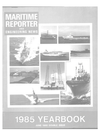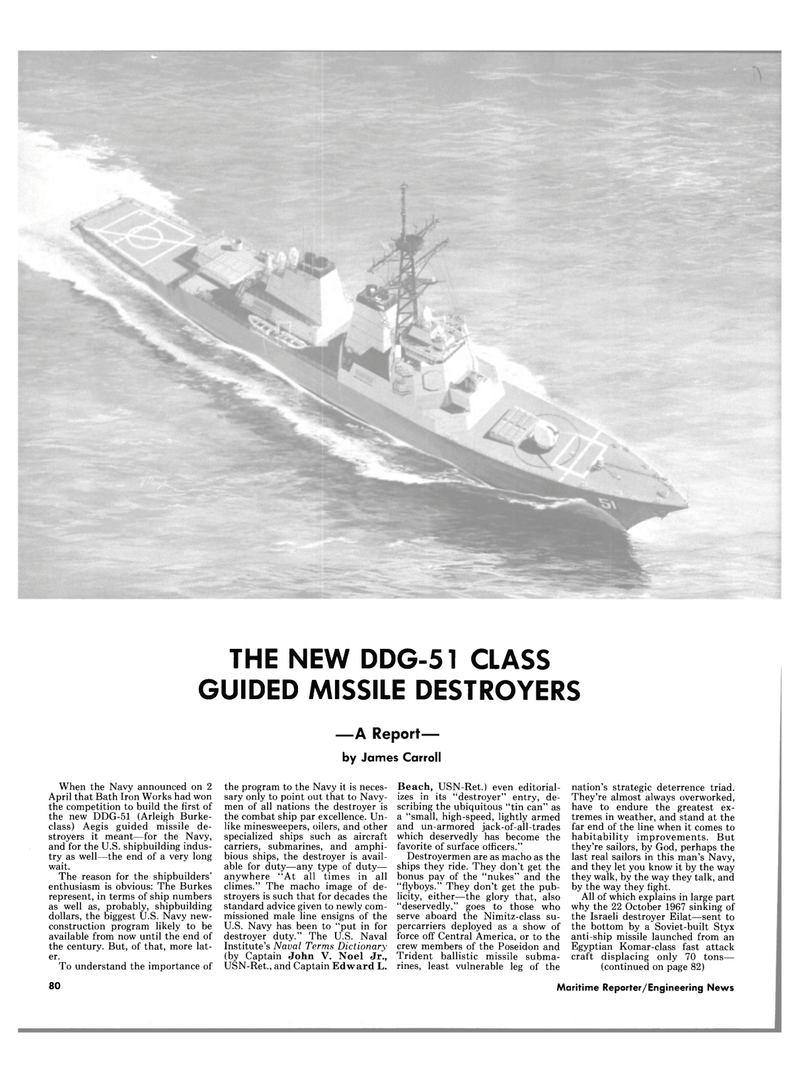
Page 82: of Maritime Reporter Magazine (June 1985)
Read this page in Pdf, Flash or Html5 edition of June 1985 Maritime Reporter Magazine
V-
THE NEW DDG-51 CLASS
GUIDED MISSILE DESTROYERS —A Report— by James Carroll
When the Navy announced on 2
April that Bath Iron Works had won the competition to build the first of the new DDG-51 (Arleigh Burke- class) Aegis guided missile de- stroyers it meant—for the Navy, and for the U.S. shipbuilding indus- try as well—the end of a very long wait.
The reason for the shipbuilders' enthusiasm is obvious: The Burkes represent, in terms of ship numbers as well as, probably, shipbuilding dollars, the biggest U.S. Navy new- construction program likely to be available from now until the end of the century. But, of that, more lat- er.
To understand the importance of the program to the Navy it is neces- sary only to point out that to Navy- men of all nations the destroyer is the combat ship par excellence. Un- like minesweepers, oilers, and other specialized ships such as aircraft carriers, submarines, and amphi- bious ships, the destroyer is avail- able for duty—any type of duty— anywhere "At all times in all climes." The macho image of de- stroyers is such that for decades the standard advice given to newly com- missioned male line ensigns of the
U.S. Navy has been to "put in for destroyer duty." The U.S. Naval
Institute's Naval Terms Dictionary (by Captain John V. Noel Jr.,
USN-Ret., and Captain Edward L.
Beach, USN-Ret.) even editorial- izes in its "destroyer" entry, de- scribing the ubiquitous "tin can" as a "small, high-speed, lightly armed and un-armored jack-of-all-trades which deservedly has become the favorite of surface officers."
Destroyermen are as macho as the ships they ride. They don't get the bonus pay of the "nukes" and the "flyboys." They don't get the pub- licity, either—the glory that, also "deservedly," goes to those who serve aboard the Nimitz-class su- percarriers deployed as a show of force off Central America, or to the crew members of the Poseidon and
Trident ballistic missile subma- rines, least vulnerable leg of the nation's strategic deterrence triad.
They're almost always overworked, have to endure the greatest ex- tremes in weather, and stand at the far end of the line when it comes to habitability improvements. But they're sailors, by God, perhaps the last real sailors in this man's Navy, and they let you know it by the way they walk, by the way they talk, and by the way they fight.
All of which explains in large part why the 22 October 1967 sinking of the Israeli destroyer Eilat—sent to the bottom by a Soviet-built Styx anti-ship missile launched from an
Egyptian Komar-class fast attack craft displacing only 70 tons— (continued on page 82) 80 Maritime Reporter/Engineering News

 81
81

 83
83
